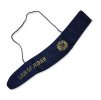Shofar
Bestsellers
The shofar (שופר) is a fascinating and deeply symbolic Jewish ritual object with a rich history and significance. It is an unadorned animal horn that holds an extraordinary position in Jewish tradition. Its origin dates back to biblical times when, according to the Torah, it first sounded during G-d's revelation on Mount Sinai. This moment is considered one of the most important in Jewish history.
Ram's horn is most commonly used to make the shofar, which is even prescribed for the holiday of Rosh Hashanah. However, horns of other kosher animals such as goats, antelopes, or gazelles can also be used. Interestingly, the use of cow's horn is expressly forbidden, which has deep religious reasons.
The shofar plays a key role during the holiday of Rosh Hashanah, the Jewish New Year. During this period, it is blown after each morning service, which has deep spiritual significance and serves as a reminder of G-d's presence and a call to repentance. In addition, the shofar is used on other significant occasions. For example, it announces the end of the fast on Yom Kippur, the holiest day of the Jewish calendar.
In modern Israel, the shofar has also gained secular significance, becoming part of the inauguration ceremony of the state president. This connection between tradition and the present shows how deeply the shofar is rooted in Jewish culture and identity.
It is important to mention that blowing the shofar is not random, but follows precise rules. There are specific ways of blowing for individual holidays and occasions that must be strictly observed. This precise adherence to tradition underlines the sacredness of the shofar and its irreplaceable role in Jewish religious life.
How to correctly determine the size of a shofar?
A) Yemenite shofar - (You need to measure around the outer curve of the shofar)



B) Ram horn shofar - (You need to measure around the outer curve of the shofar)







